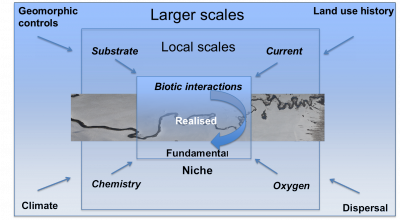Difference between revisions of "Why aren’t relationships stronger?"
(Created page with "That there is not a clear-cut link between hydromorphological degradation and biota is not completely surprising. A number of processes will create noise in the data. In cases...") |
(No difference)
|
Latest revision as of 16:07, 4 December 2015
That there is not a clear-cut link between hydromorphological degradation and biota is not completely surprising. A number of processes will create noise in the data. In cases with a strong gradient in degradation and in highly stressed conditions (for instance oxygen depletion or very acidic conditions), this noise will have little influence on the biological signal. In many cases, however, degraded hydromorphological conditions appear to give a less univocal signal because species loss is not clearly related and noise from other factors is likely to mask part of the response. The way rivers are assessed today ignores some of the reasons why this variability in response occurs. Ecological status in rivers is monitored at local scales, typically in reaches ranging from tens of metres to a few hundreds of metres, depending on biological quality element and river size. Currently used assessment systems are based on community composition of the different biological quality elements, which is expected to be a product of local environmental filters such as water quality and hydromorphological conditions. Filters will sieve away species that cannot exist in the environmental conditions found at a given location because they are outside their fundamental niche requirements. A prime example is the many species of stoneflies that will disappear if local oxygen concentrations drop beyond a certain level. Besides these local environmental conditions, however, also other conditions affect community composition. Biotic interactions at local scales may restrict the niche width of individual species by, for instance, predation or competition. Processes occurring at larger scales influence local conditions too.
These larger-scale conditions can influence biota directly by differences in dispersal abilities from “meta-communities” surrounding a local river site. If certain species have favourable conditions upstream a given sampling site and high dispersal capability, they can appear frequently in samples at the local scale although the environment is unfavourable. Likewise, lack of colonization potential due to low dispersal rates will limit the number of species at local scales irrespective of the environmental conditions. Indirectly, large-scale drivers such as geomorphic controls, climate and land use history will influence local environmental conditions. Findings in REFORM suggest that the inclusion of measurements of biotic interactions and factors acting on larger scales could be instrumental for our ability to detect the biological response to hydromorphological degradation in river ecosystems.
